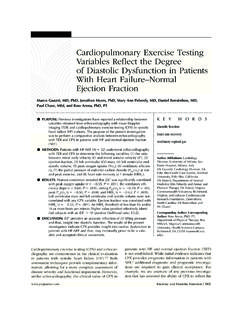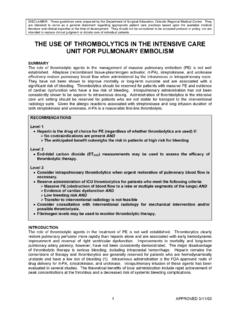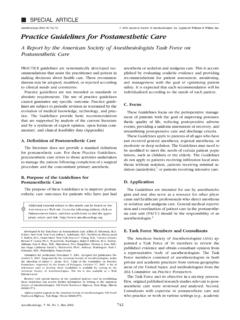Transcription of 235 Maternal Sepsis - FRCA
1 Sign up to receive ATOTW weekly - email DIAGNOSIS AND management OF Maternal . Sepsis AND SEPTIC SHOCK. ANAESTHESIA TUTORIAL OF THE WEEK 235. 8TH AUGUST 2011. Caroline Cormack University College London Hospital, United Kingdom Correspondence to QUESTIONS. Before continuing with this tutorial, try to answer the following questions. The answers and a brief explanation can be found at the end of the article. 1. Regarding the most recent (2006-2008) triennial report of UK Maternal deaths from the Centre for Maternal and Child Enquiries (CMACE). a. Sepsis was the second most common cause of direct Maternal death after thromboembolic disease b. Deaths from -haemolytic streptococcus Group B infection have increased in the UK.
2 C. The use of early warning scoring charts to monitor obstetric patients in hospital was recommended d. Substandard care did not occur in any of the Sepsis related deaths 2. Maternal Sepsis and infection a. Often presents early due to the physiological changes of pregnancy b. May present with hypothermia c. Is most commonly due to bacterial pathogens d. May warrant hysterectomy as part of its management 3. Regarding the management of Sepsis and septic shock a. Antibiotic therapy should always be delayed until all necessary cultures have been taken b. A target haemaglobin over 10g/dl should be maintained c. Steroids are not recommended in the management of septic shock d. A central venous oxygen saturation 65% is a goal of resuscitation INTRODUCTION.
3 Pregnant women are vulnerable to infection and their pregnant state increases their risk of developing serious complications from an infection. Worldwide, infection and the complications of Sepsis are among the most common causes of severe Maternal morbidity and mortality. In the UK, Sepsis is the leading cause of direct Maternal death. The most recent triennial report (2006- 2008) of Maternal deaths from the Centre for Maternal and Child Enquiries (CMACE) found that deaths from Sepsis have risen rather than declined in recent time, in contrast to the other major causes of direct Maternal The increased number of deaths secondary to community-acquired - haemolytic streptococcus Group A infection has been postulated as the main reason for the rise in Sepsis related mortality.
4 This article will discuss the early identification of Maternal Sepsis , the physiological changes that make pregnant women more susceptible to the complications of Sepsis and current recommendations for the diagnosis and management of Sepsis and septic shock in pregnancy. ATOTW 235 maternal sepsis 08/08/2011 Page 1 of 7. Sign up to receive ATOTW weekly - email DEFINITIONS. Bacteraemia - viable bacteria in blood. Infection - inflammatory response to the presence of a microorganism in normally sterile tissue. Systemic Inflammatory Response Syndrome (SIRS) - an inflammatory response diagnosed by two or more of the variables shown below: Fever or hypothermia (core temperature < 36 C or > 38 C). Tachycardia (Heart Rate (HR) > 90 / min).
5 Tachypnoea (Respiratory Rate (RR) > 20 / min). White cell count (WCC) >12 x 109 /l or < 4 x 109 /l o NB: above criteria relate to non-pregnant patients. 2. Average WCC in third trimester is x 109/l WCC range in pregnancy: - x 109/l Post delivery WCC: 20 - 30 x 109/l Sepsis - SIRS in the presence of infection. Severe Sepsis - Sepsis with associated organ dysfunction, hypotension or hypoperfusion. Septic shock - Sepsis + refractory arterial hypotension despite adequate fluid resuscitation. FEATURES OF SEVERE Sepsis . Hypotension Arterial hypoxaemia Raised lactate Acute oliguria (urinary output < ml/kg/h). Deranged renal function Deranged liver function Altered mental status Coagulation abnormalities Hyperglycaemia in absence of diabetes Shock is a state of compromised tissue perfusion that causes cellular hypoxia leading to tissue hypoxia and vital organ dysfunction.
6 During shock, perfusion is insufficient to meet the metabolic demands of the tissues and anaerobic metabolism occurs. This is unsustainable and, if not corrected, will progress to cellular dysfunction, cell death and end organ damage. PHYSIOLOGICAL CHANGES OF PREGNANCY IN RELATION TO Sepsis . AND SEPTIC SHOCK. A number of physiological changes occur in pregnancy and several of these changes will increase susceptibility to infection or the consequences of it. Cardiovascular System In early pregnancy, circulation becomes hyperdynamic with a reduced systemic vascular resistance (SVR). Maternal cardiac output increases steadily as a result of increased heart rate and stroke volume, reaching a peak of 30-50% above pre-pregnant values by approximately 30 weeks gestation.
7 A 40%. increase in blood volume occurs, reaching a maximum at about 32 weeks gestation. The heart may be considered to be under ever increasing stress as a normal pregnancy progresses. If a pregnant woman develops Sepsis , this stress on her heart will be further compounded by Sepsis -induced reduction in SVR, vasodilation and myocardial depression, which may result in rapid haemodynamic collapse. Additionally, in normal pregnancy, there is a reduction in serum albumin which affects colloid osmotic pressure making women more vulnerable to pulmonary oedema should cardiac failure occur. ATOTW 235 maternal sepsis 08/08/2011 Page 2 of 7. Sign up to receive ATOTW weekly - email Respiratory System As pregnancy progresses, increased minute ventilation occurs and results in a mild respiratory alkalosis despite a reduced tidal volume.
8 There is a compensatory mild metabolic acidosis. These factors will reduce a woman's ability to compensate for any acidosis that develops as part of Sepsis and septic shock, particularly if there is any respiratory failure. Renal System Ureteric dilatation, caused by smooth muscle relaxation, and compression of the ureters by the gravid uterus as they pass over the pelvic rim increase the risk of pyuria and pyelonephritis. RECOGNITION OF Sepsis AND SEPTIC SHOCK. Pregnant women with Sepsis can deteriorate and die rapidly after the onset of symptoms. Prompt recognition, stabilisation and treatment of the underlying cause can avoid the rapidly spiralling deterioration that leads to cell death and, ultimately patient death.
9 The recognition of shock is clinical and depends on identification of the cluster of subtle signs that indicate developing tissue hypoxia and organ dysfunction. Tachypnoea and tachycardia are often early signs, followed by hypotension and poor urine output. It is only once shock has progressed some way that the patient will also show the classical picture of pale, clammy skin, cool peripheries and altered level of consciousness. The altered physiology of a pregnant woman may obscure the early signs of developing shock, making recognition and early treatment even more difficult. In the UK, Maternal death enquiries have repeatedly shown that failure to recognise developing Sepsis and septic shock and late, inadequate or inappropriate treatment of shock, contributes to Maternal death.
10 The most recent CMACE report into Maternal deaths emphasises early recognition of the following signs and symptoms of Maternal Sepsis : 1. Pyrexia - this is common but its absence does not rule out Sepsis Hypothermia - a significant finding that may indicate severe infection Persistent tachycardia >100 beats per minute Tachypnoea (RR >20 breaths/min) - may be considered Sepsis until proven otherwise Leucopaenia (WCC <4 x 109/l). Diarrhoea and/or vomiting Lower abdominal pain Abnormal or absent fetal heart beat A key recommendation of the last two Maternal death reports is that in all hospitals, Modified Early Obstetric Warning Scoring (MEOWS) charts should be used to aid timely recognition, treatment and referral of women who have or who are developing a critical condition.















